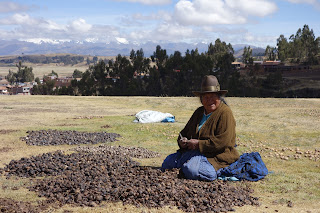向南美出發 Day 4
導遊Naomi生於此地,所以很細心的講解 ,原來在這裡有2000 多種薯仔。而印加人主要利用梯田,輪耕方式,在潮濕的夏季耕作。在乾旱季節給田地,休養生息。田的旁邊用大石頭作為屏障,阻擋山泥下滑,在泥土方面就把gravel放最底疏水,clay 放最面保水同保持養份。印加人的農耕文化和智慧真的和中國近似。
Chincheros Inca ruins
Your
tour guide will pick you up from your hotel/hostal at 8:00am and you will
travel by minivan to the amazing village of Chincheros.
之後,我們也到了一個叫maras 的同心圓,這是一個小山谷,用了微氣候的原理,據說身在山谷底部是最溫暖,因為山坡反射熱力出來,而這是有屏蔽的地方可以檔風。到了晚上,內陸水氣少無雲。天氣開始變冷,同心圓上空的空氣都是冷冷的,但同心圓的底部都是暖暖的,所以原本在高地不能種的植物例如棉花、可可葉就可以在這個山谷種植,真聰明啊。
Moray 農業實驗室 (Credit: The only Peru Guide)
Moray 農業實驗室 (Credit: The only Peru Guide)
之後,我們去MARAS SALT MINE/ Salineras de Maras (鹽田),而鹽的由來要追塑到版塊活動,在納斯卡版塊下沉(subduction)
而仍成今天的南美洲,這地方從前是海洋,所以,在推擠作用底下,海底的沉積層岩石被褶曲抬升,這個地方就有鹽水,它是秘魯唯一的鹽田。
Salt water in the Andes? Credit: Peru for Less
You might be wondering how large amounts of salt deposits ended up in the middle of the Andes Mountains. Though the salt pans themselves are man-made, the water that is channeled through them comes from a subterranean natural spring, which is mixed with salt deposits from prehistoric salt lakes. Over millions of years, tectonic plate movement has buried the deposits deep beneath the mountains: the salt is accessible from an underground water flow of brine -a mixture of salt and water – that bubbles up in a natural spring near the small town of Maras. It’s believed that the salt pans were originally constructed by the Wari civilization, which predates the Inca. However, the Inca saw the economic opportunity in harvesting the salt of Maras and expanded the salt pans further up the mountainside.The salt is mined through the evaporation of the brine that is channeled into the pans. When the water evaporates, members of the local communities carefully scrape the salt crystals from the earthen surfaces. When all of the crystals are removed, the pan is filled with the salt water again – a process that has been practiced since before the time of the Inca.Today there are over 6,000 salt pans near Maras, and each one is no more than 13 square feet and less than 1 foot deep. Each pan is owned and mined by a local family of the Maras community, and the salt is collected and sold in local shops or nearby towns.
之後,我們坐Inca express 火車到馬丘比丘,真是又肚餓又累。又好似有少許高反,噁心想吐,很累很累。
到了火車站,另一位導遊Carlo 沒有準時出現。我們也很不客氣,但其實他也是很辛勞工作的人。
Machu Picchu 是一個山城,充滿遊客,餐飲貴少少加10% service charge. 到了晚上也有點冷,冬天比Cusco 暖和。
向南美出發預備篇
DAY 1 21/7 HONG KONG/DALLAS (US)
DAY 2 22/7 DALLAS (US)/LIMA(PERU)/CUSCO(LIMA)
DAY 3 23/7 Cusco/Peru
DAY 4 24/7 Cusco/Moray, Salinas de Maras/Peru
DAY 5 25/7 Machu Picchu/Peru
DAY 6 26/7 Rainbow mountain
DAY 7 27/7 Cusco/Peru-->Puno/Peru
DAY 8 28/7 Puno/Peru
DAY 9 29/7 Puno/PeruàLa Paz/Bolivia
DAY 10 30/7 La Paz/Bolivia
DAY 11 31/7 Uyuni/Bolivia
DAY 12 01/8 Uyuni/Bolivia
DAY 13 02/8 Uyuni/Bolivia
DAY 14 03/8 Uyuni/BoliviaàPedro de Atacama/Chile
DAY 15 04/8 Pedro de Atacama -> Santiago/Chile
DAY 16 05/8 Santiago-->Easter Island/Chile
DAY 17 06/8 Easter Island/Chile
DAY 18 07/8 Easter Island/Chile
DAY 19 08/8 Easter Island/Chile
DAY 20 09/8 Easter IslandàSantiago/Chile
DAY 21 10/8 Santiago
DAY 22 11/8 SANTIAGO (CHILE)
DAY 2312/8 DALLAS (US)
DAY 2413/8 HONG KONG






































































沒有留言:
張貼留言